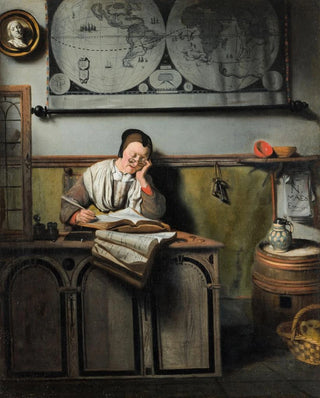Art print | The accountant - Nicolaes Maes


View from behind

Frame (optional)
In the vibrant world of 17th-century Dutch painting, "The Accountant" by Nicolaes Maes stands out for its intimate atmosphere and penetrating gaze into everyday life. This artwork, which captures the very essence of bourgeois life of the period, invites the viewer to immerse themselves in a moment of concentration and reflection. The piece, both simple and complex, reveals a man absorbed in his tasks, illustrating the rigor and diligence characteristic of the accountant profession. Through the subtle play of light and shadow, Maes manages to create an almost tangible ambiance, where every detail matters and the psychological depth of the characters is expressed with striking clarity.
Style and uniqueness of the work
Nicolaes Maes's style is characterized by an exceptional mastery of chiaroscuro, a technique that allows playing with lights to emphasize the emotions and inner states of the depicted subjects. In "The Accountant," the subdued lighting highlights the protagonist's face, revealing an expression of intense concentration, while the background gently fades into shadow. This approach creates an atmosphere of serenity and introspection, inviting the viewer to ponder the thoughts crossing this character's mind. The meticulously rendered details, such as desk objects and clothing textures, testify to Maes's skill in observing and reproducing reality with unparalleled precision. Thus, the artwork transcends mere representation to become a true reflection on human nature and daily life.
The artist and his influence
Nicolaes Maes, a pupil of Rembrandt, belongs to the lineage of great masters of Dutch painting. His career, marked by stylistic evolution, bears witness to the indelible influence of his master while developing a distinctive voice. Focusing on scenes of everyday life, Maes manages to capture moments of truth, revealing the richness of human interactions. His work has not only influenced his contemporaries but has also left a lasting imprint on subsequent generations of artists. By exploring themes such

Matte finish

View from behind

Frame (optional)
In the vibrant world of 17th-century Dutch painting, "The Accountant" by Nicolaes Maes stands out for its intimate atmosphere and penetrating gaze into everyday life. This artwork, which captures the very essence of bourgeois life of the period, invites the viewer to immerse themselves in a moment of concentration and reflection. The piece, both simple and complex, reveals a man absorbed in his tasks, illustrating the rigor and diligence characteristic of the accountant profession. Through the subtle play of light and shadow, Maes manages to create an almost tangible ambiance, where every detail matters and the psychological depth of the characters is expressed with striking clarity.
Style and uniqueness of the work
Nicolaes Maes's style is characterized by an exceptional mastery of chiaroscuro, a technique that allows playing with lights to emphasize the emotions and inner states of the depicted subjects. In "The Accountant," the subdued lighting highlights the protagonist's face, revealing an expression of intense concentration, while the background gently fades into shadow. This approach creates an atmosphere of serenity and introspection, inviting the viewer to ponder the thoughts crossing this character's mind. The meticulously rendered details, such as desk objects and clothing textures, testify to Maes's skill in observing and reproducing reality with unparalleled precision. Thus, the artwork transcends mere representation to become a true reflection on human nature and daily life.
The artist and his influence
Nicolaes Maes, a pupil of Rembrandt, belongs to the lineage of great masters of Dutch painting. His career, marked by stylistic evolution, bears witness to the indelible influence of his master while developing a distinctive voice. Focusing on scenes of everyday life, Maes manages to capture moments of truth, revealing the richness of human interactions. His work has not only influenced his contemporaries but has also left a lasting imprint on subsequent generations of artists. By exploring themes such






